-

人教版新目标初中英语七年级下册Why do you like koalas教案2篇
单元整体说明(一)单元教材分析本单元的核心话题是描述动物和表达个人喜好,以及句式why do you like…? Because…。这也是本单元的教学重点。通过本单元的学习,学生应能较流利地运用所学词汇和句型描述动物,表达个人喜好。(二)单元知识结构1.词汇动物名称 tiger, elephant, koala, dolphin, etc.词汇描述性形容词: smart, cute, ugly, clever, shy, etc.国家名: Australia, South Africa2.句型Why do you like koala hears? Because they are cute.Where are pandas from? They're from China.What animals do you like? I like dolphins.(三)单元整体目标1.Master the vocabulary2.Master and use: Why do you like koalas? Because they am cute.Where are pandas from? They're from China.What animals do you like? I like dolphins.(四)单元教学重难点一览(五)单元学情分析学生此前已经学过由why, where, what 引导的特殊疑问句句型,具有了学习本单元知识的认知前提。形形色色的动物能激发学生的好奇心,产生了解它们的欲望,这有利于本单元知识的教学和学生学习兴趣的培养。

人教版新目标初中英语八年级下册Have you ever been to an amusement park教案
(1)Have you ever been to …? Yes, I have. / Yes, I have ever been to …No, I haven’t. / No, I have never been to …(2)When did you go there? I went there last year. (3)I have never been to a water park. Neither have I. I have ever been to an amusement park. So have I. (4)How long have you been studying English? I’ve been studying English since nine o’clock. I’ve been studying English since I came back home. I’ve been studying English for five hours. (5)What’s that? It’s an amusement park in Japan. I’ve never been to an amusement park like it before. It’s fun to learn another language. Let’s go tonight. Isn’t this great?space museum, amusement park, water park, South America, Peru, Holland, European culture, tour guide, flight attendant, musical instrument, more than, be from, get to, take lessons, neither, discover, graduate, change

人教版新目标初中英语八年级下册If you go to the party, you’ll have a great time教案2篇
区分宾语从句、定于从句和状语从句宾语从句和状语从句,都叫做主从复合句。宾语从句主要是中考必考的,是初中阶段必掌握的从句,宾语从句主要是掌握三要素,所谓宾语从句,就是宾语在主从复合句当中充当宾语的一个句子,叫做宾语从句。主句的谓语动词是及物动词,后面如果是词或者是短语的话,是简单句,如果是句子的话,肯定是宾语从句。I know that he good at English.就是宾语从句,三要素,一要素是要注意连词,连词一共学了三类连词,一类连词是that口语当中可以省略,就像刚才说的那一句,I hear he is good at English.还有疑问代词、疑问副词,how where when,疑问代词、疑问副词。还有一类连词weather是否的意思,不是状语从句当中的如果,这一定要和如果区分开,这是是否。I don't know if he interested at English。宾语从句要注意if是连词。第二要素是语序,要用陈述举语序。比如说你家有几口人,我们都说How many people are there in you family?但是这是简单句,一旦说成宾语从句,你可以告诉我你家有几口人吗?Could you tell me how many people there are in you family ?

人教版新目标初中英语八年级下册It’s a nice day, isn’t it教案2篇
"Hello! Welcome to English class! Introduce yourself. Meet your new classmates." That's what the teacher says. What do you say? "Oh no!" It can be difficult talking to new people. But it can be fun, and you can make friends. How do you do it? Make small talk. Small talk is polite conversation. "Wang Nan is a great pingpang player, isn't she?" "I'd love to meet her, wouldn't you?" "It's been raining a lot, hasn't it?" Tag questions are a form of polite speech. To make small talk successfully, you should know how to make them. You should also know what topics to talk about. Try to learn this unit carefully. The next time you're in English class, you'll find out. Making small talk's easy, isn't it? (“你好!欢迎你!请做一下自我介绍。认识一下你的新同学。”通常在课上老师会这样说。你会说什么呢?“噢,不!”与陌生人谈话太困难了。但是这也很有意思,并且你还能交到朋友。你该怎么做呢?闲聊。闲聊指得是礼貌的对话。“王楠是一个很棒的乒乓球运动员,不是吗?”“我希望自己能认识她,你呢?“今年的雨水很多,不是吗?”反意疑问句是一种礼貌用语。为了使得谈话成功,你应该知道怎样去进行闲聊。你还应该知道与不同的人该谈论什么样的话题。认真的学习这个单元吧,下次在英语课上,你会发现与大家展开谈话是一件很容易的事情,不信我们来试试。)

人教版新目标初中英语八年级下册He said I was hard-working教案2篇
This activity introduces some new vocabulary and provide oral practice using the target language.Task 1 . Ask four students to stand in front of the class, and the teacher asks them the following questions as a reporter.1.What are you going to do when you grow up?2.What are you going to do next week?3.What are going to do after school?The students will give different answers, then ask a good student to report what they said.I am going to e a doctor.What did she say?----------She said she was going to be a doctor.I am going to have a party on Friday night.What did he say?-------He said he was going to have a party on Friday night.I am going to do my homework.What did she say ?------ She said she was going to do her homework.I am going home after school.What did she say?-----She said she was going home after school.Say In this unit we are going to learn to use words like to report what someone said.Task 2. Read the instructions. Then ask a student to read the four questions. And write the words on the Bb. Explain what soap opera is.Task 3. Ask the students to Look at the pictures, point out the TV screens in the picture. Ask one girl to read what Marcia said.What did Marcia say? She said She said she was having a surprise party for Lana on Friday night. Repeat the other pictures in the same way.Activity3. Listen and number the pictures in activity 1a.

人教版新目标初中英语八年级下册How long have you been collecting shells教案2篇
Step Ⅱ Show the new words on the screen and teach the new words. Read the new words to students and ask them to repeat.Step Ⅲ 3aThis activity introduces new vocabulary and provides reading practice using the target language.In this activity first look at the four pictures.T: What can you see in the pictures?Ss: Four snow globes.T: Right. There are four snow globes in the pictures. And what are they?Ss: They are a monster, two polar bears, two penguins and a birthday cake.Write these words on the blackboard: snow globe; monster; polar bear; penguin and birthday cake. Read them to the class and ask students to repeat each one. Make sure students understand each word.Use a computer to show the E-mail message on the screen and read the message to students.Get students to read the e-mail on their own, and then draw lines connecting each snow globe and its description.Correct the answers.AnswersA line should connect each snow globe picture with the words that describe it in the letter.Step Ⅳ 3bThis activity provides writing practice using the target language.First review Activity 2a on Page 47.Then ask students to complete the message according to Activity 2a.Some partial sentences are given to students. Write about one person's collection.When students work, walk around the room checking the progress and offering help as needed.When they finish, ask some students to read their messages to the class.

人教版新目标初中英语八年级下册What were you doing when the UFO arrived教案2篇
(一).知识方面: 1.培养学生能运用过去进行时来描述、谈论过去某个时间正在发生的事情或动作的意识和能力,能就过去某个时间正在发生的动作做出正确的描述。 2.培养学生的想象力和角色扮演的合作能力。 3.培养学生讲述过去发生的事情经过的能力。能正确运用一般过去时来讲述故事。 (二).技能方面: 1.本单元的语言目标是Talk about past events and tell a story(谈论过去的时间和讲述一个故事),围绕这一目标,要涉及句型: What were you doing when the UFO arrived? ----I was sitting in the barber’s chair. The barber was cutting my hair. 因此必须学习standing、studying、cleaning、sleeping、cooking、making、eating、cutting、等表示地点的词,以便为上述句型提供语言材料。2.学习过去进行时的有关知识。Was/were+现在分词,是该时态的表达式。 3.在学习过程中,要区分The boy was walking down the street when the UFO landed.和While the boy was walking down the street, the UFO landed.这两种由when和while引导的状语从句的句型结构。注意它们的不同。

人教版新目标初中英语八年级下册Why don’t you get her a scarf教案
教师带领学生复习有关描述宠物的词汇,采用教师提问学生回答的方进行。如:T:What animals do you think would be good pets?What animals do you think would be bad pets?What do you think are good animals for a six-year-old child?然后学生进行 pairwork 练习。Task two: 师生互动,学习探究 1、播放3a部分的录音,引导学生一边听录音,一边跟读。2、通过听录音学生回答以下问题:Why do you think pot-bellied pigs are popular?What are the advantages and disadvantages of keeping such a pet?教师对学生的回答进行及时点评。3.学习范文,学习重点短语,为下步的模仿写作提供语言素材。T :1. )Have you ever kept a pig as a pet?Do you like pigs? St.:No.…Why don’t you like to keep a pig? St: No.They’re too dirty and lazy(Do you know in some foreign countries like Hollyland, Australia,pigs are the most popular pet.there’s a kind of pig.(图)it has an interesting name? it ‘s called a pot-bellied pig.) Now,let’s learn an article about this kind of interesting pet.2.)play the tapeSt.:Listen and repeat3.)show some Qs on computer(本子St.: read silently,then answerthe Qs(本子)4.)Ask ss. Close book and retell this passage.(what is a pot-bellied pig? Is it a good or bad pet? ) St.: retell it to each other“A pot –bellied pig is a popular pet now…”5.read the article together.St.:.practice reading

人教版新目标初中英语八年级下册Would you mind turning down the music教案
Step 4. Group work (4)1. Ask a pair of students to read the dialogue. Say, This activity provides speaking, listening and writing practice using the target language.2. Ask students to complete the work in groups.3. Check the answers with the whole class. 4. Explain some of the language points. Step 5. Word review (Self check 1)1. Ask students to read the words and the phrases given. 2. Fill in the blanks with proper forms of these words to complete the sentences. 3. Check the answers with the whole class. Homework:Do activity 2 on page 57 after class. Period 6Teaching aims: 1. Teach vocabulary words and the useful expressions. 2. Enable the students to learn etiquette in different culture. 3. Help the students learn how to behave politely in public places and in daily life. Teaching procedures:Step 1. RevisionHelp students to review the function of making requests through a free talk. Then lead them to the topic of etiquette. Explain the meaning of etiquette. Or, ask students to look it up in the dictionary. Step 2. Pre-reading (Section 1)1. Ask students to read the picture and make a list with their partner about how many rules of etiquette can be seen being broken.

人教版新目标初中英语八年级下册What should I do教案2篇
说明:在帮Li Lei提建议的同时,教育学生如何学好英语。第三课时教学目标1. 语言目标:a) 词汇: Original, in style, haircut, the same as.b) 语言结构:My friend wears the same clothes and has the same haircut as I do.2. 能力目标:大多数学生能够谈论自己喜欢哪种服装,提高查找信息的能力。3. 情感目标:学会如何与朋友相处,要有自己对时尚的看法。教学重点掌握一些重要词汇。教学难点学会谈论问题,并能提出书面建议。◆教学突破首先针对Erin的问题,提出个人的建议,模仿2c部分的对话展开双人交际Pair-work;听老师诵读3a部分的信件,并找出LEFT OUT的问题所在;学生完成3b部分的内容,给Left Out提出书面的建议;学以口头形式提出自己目前存在的某个问题,讲给大家听,让同学们给自己提出一个建议,并作笔录;学生两、三个人分成一组,随意性地进行口语交际,谈论P14的第4部分的某个问题,相互交换意见。
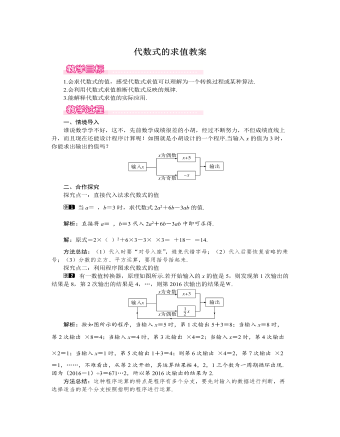
北师大初中七年级数学上册代数式的求值教案1
(1)请你用代数式表示水渠的横断面面积;(2)计算当a=3,b=1时,水渠的横断面面积.解析:(1)根据梯形面积=12(上底+下底)×高,即可用含有a、b的代数式表示水渠横断面面积;(2)把a=3、b=1带入到(1)中求出的代数式中,其结果即为水渠的横断面面积.解:(1)∵梯形面积=12(上底+下底)×高,∴水渠的横断面面积为:12(a+b)b(m2);(2)当a=3,b=1时水渠的横断面面积为12(3+1)×1=2(m2).方法总结:解答本题时需搞清下列几个问题:(1)题目中给出的是什么图形?(2)这种图形的面积公式是什么?(3)根据公式求图形的面积需要知道哪几个量?(4)这些量是否已知或能求出?搞清楚了这些问题,求解就水到渠成.三、板书设计教学过程中,应通过活动使学生感知代数式运算在判断和推理上的意义,增强学生学习数学的兴趣,培养学生积极的情感和态度,为进一步学习奠定坚实的基础.
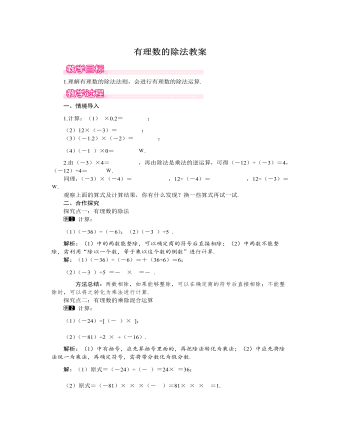
北师大初中七年级数学上册有理数的除法教案1
解析:∵ab>0,根据“两数相除,同号得正”可知,a、b同号,又∵a+b<0,∴可以判断a、b均为负数.故选D.方法总结:此题考查了有理数乘法和加法法则,将二者综合考查是考试中常见的题型,此题的侧重点在于考查学生的逻辑推理能力.让学生深刻理解除法是乘法的逆运算,对学好本节内容有比较好的作用.教学设计可以采用课本的引例作为探究除法法则的过程.让学生自己探索并总结除法法则,同时也让学生对比乘法法则和除法法则,加深印象.并讲清楚除法的两种运算方法:(1)在除式的项和数字不复杂的情况下直接运用除法法则求解.(2)在多个有理数进行除法运算,或者是乘、除混合运算时应该把除法转化为乘法,然后统一用乘法的运算律解决问题.
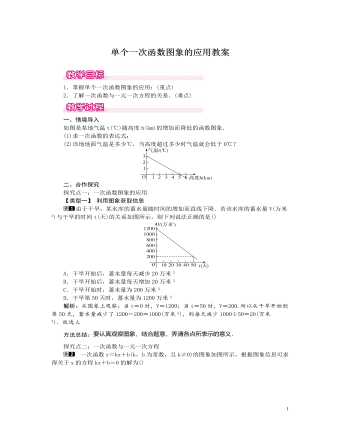
北师大初中数学八年级上册单个一次函数图象的应用1教案
方法总结:要认真观察图象,结合题意,弄清各点所表示的意义.探究点二:一次函数与一元一次方程一次函数y=kx+b(k,b为常数,且k≠0)的图象如图所示,根据图象信息可求得关于x的方程kx+b=0的解为()A.x=-1B.x=2C.x=0D.x=3解析:首先由函数经过点(0,1)可得b=1,再将点(2,3)代入y=kx+1,可求出k的值为1,从而可得出一次函数的表达式为y=x+1,再求出方程x+1=0的解为x=-1,故选A.方法总结:此题主要考查了一次函数与一元一次方程的关系,关键是正确利用待定系数法求出一次函数的关系式.三、板书设计一次函数的应用单个一次函数图象的应用一次函数与一元一次方程的关系探究的过程由浅入深,并利用了丰富的实际情景,增加了学生的学习兴趣.教学中要注意层层递进,逐步让学生掌握求一次函数与一元一次方程的关系.教学中还应注意尊重学生的个体差异,使每个学生都学有所获.
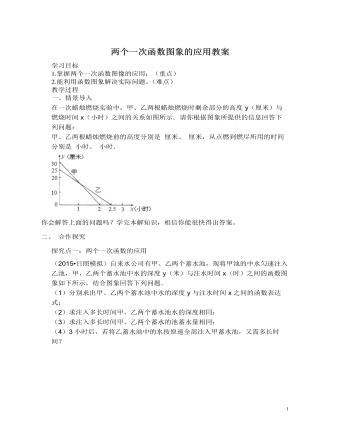
北师大初中数学八年级上册两个一次函数图象的应用2教案
学习目标1.掌握两个一次函数图像的应用;(重点)2.能利用函数图象解决实际问题。(难点)教学过程一、情景导入在一次蜡烛燃烧实验中,甲、乙两根蜡烛燃烧时剩余部分的高度y(厘米)与燃烧时间x(小时)之间的关系如图所示.请你根据图象所提供的信息回答下列问题:甲、乙两根蜡烛燃烧前的高度分别是 厘米、 厘米,从点燃到燃尽所用的时间分别是 小时、 小时.你会解答上面的问题吗?学完本解知识,相信你能很快得出答案。二、 合作探究探究点一:两个一次函数的应用(2015?日照模拟)自来水公司有甲、乙两个蓄水池,现将甲池的中水匀速注入乙池,甲、乙两个蓄水池中水的深度y(米)与注水时间x(时)之间的函数图象如下所示,结合图象回答下列问题.(1)分别求出甲、乙两个蓄水池中水的深度y与注水时间x之间的函数表达式;(2)求注入多长时间甲、乙两个蓄水池水的深度相同;(3)求注入多长时间甲、乙两个蓄水的池蓄水量相同;
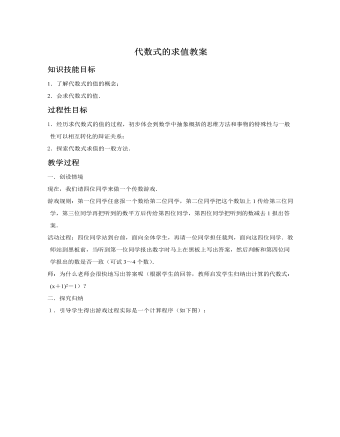
北师大初中七年级数学上册代数式的求值教案2
解 由题意可得,今年的年产值为a·(1+10%) 亿元,于是明年的年产值为a·(1+10%)·(1+10%)= 1.21a(亿元).若去年的年产值为2亿元,则明年的年产值为1.21a =1.21×2 = 2.42(亿元).答:该企业明年的年产值将能达到1.21a亿元.由去年的年产值是2亿元,可以预计明年的年产值是2.42亿元.例3 当x=-3时,多项式mx3+nx-81的值是10,当x = 3时,求该代数式的值.解 当x=-3时,多项式mx3+nx-81=-27m-3n-81, 此时-27m-3n-81=10, 所以27m+3n=-91.则当x=3,mx3+nx-81 =( 27m+3n )-81=-91-81=-172.注:本题采用了一种重要的数学思想——“整体思想”.即是考虑问题时不是着眼于他的局部特征,而是把注意力和着眼点放在问题的整体结构上,把一些彼此独立,但实质上又相互紧密联系着的量作为整体来处理的思想方法.
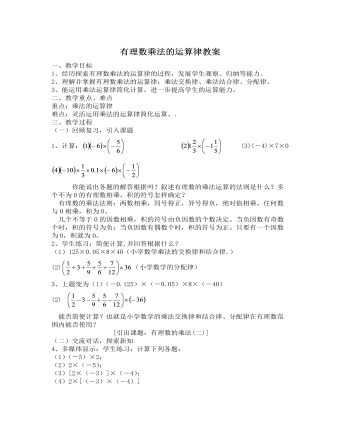
北师大初中七年级数学上册有理数乘法的运算律教案2
分析:(1)(2)用乘法的交换、结合律;(3)(4)用分配律,4.99写成5-0.01学生板书完成,并说明根据什么?略例3、某校体育器材室共有60个篮球。一天课外活动,有3个班级分别计划借篮球总数的 , 和 。请你算一算,这60个篮球够借吗?如果够了,还多几个篮球?如果不够,还缺几个?解:=60-30-20-15 =-5答:不够借,还缺5个篮球。练习巩固:第41页1、2、7、探究活动 (1)如果2个数的积为负数,那么这2个数中有几个负数?如果3个数的积为负数,那么这3个数中有几个负数?4个数呢?5个数呢?6个数呢?有什么规律? (2)逆用分配律 第42页 5、用简便方法计算(三)课堂小结通过本节课的学习,大家学会了什么?本节课我们探讨了有理数乘法的运算律及其应用.乘法的运算律有:乘法交换律:a×b=b×a;乘法结合律:(a×b)×c=a×(b×c);分配律:a×(b+c)=a×b+a×c.在有理数的运算中,灵活运用运算律可以简化运算.(四)作业:课本42页作业题
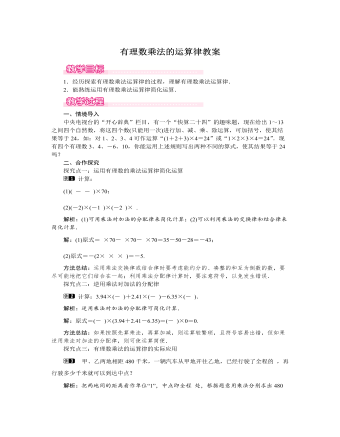
北师大初中七年级数学上册有理数乘法的运算律教案1
解:原式=(-47)×(3.94+2.41-6.35)=(-47)×0=0.方法总结:如果按照先算乘法,再算加减,则运算较繁琐,且符号容易出错,但如果逆用乘法对加法的分配律,则可使运算简便.探究点三:有理数乘法的运算律的实际应用甲、乙两地相距480千米,一辆汽车从甲地开往乙地,已经行驶了全程的13,再行驶多少千米就可以到达中点?解析:把两地间的距离看作单位“1”,中点即全程12处,根据题意用乘法分别求出480千米的12和13,再求差.解:480×12-480×13=480×(12-13)=80(千米).答:再行80千米就可以到达中点.方法总结:解答本题的关键是根据题意列出算式,然后根据乘法的分配律进行简便计算.新课程理念要求把学生“学”数学放在教师“教”之前,“导学”是教学的重点.因此,在本节课的教学中,不要直接将结论告诉学生,而是引导学生从大量的实例中寻找解决问题的规律.学生经历积极探索知识的形成过程,最后总结得出有理数乘法的运算律.整个教学过程要让学生积极参与,独立思考和合作探究相结合,教师适当点评,以达到预期的教学效果.
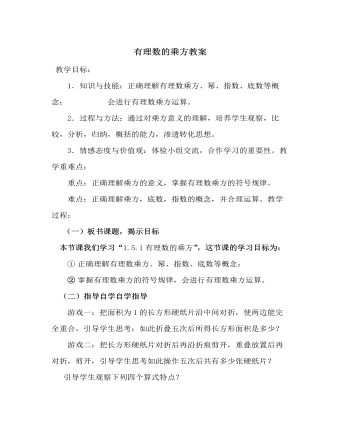
北师大初中七年级数学上册有理数的乘方教案2
二.思考:(-2) 可以写成-2 吗?( ) 可以写成 吗?(指名学生回答,师生共同总结:负数和分数的乘方书写时,一定要把整个负数和分数用小括号括起来)三.计算:①(-2) ,②-2 ,③(- ) ,④ (叫4个学生上台板演,其他练习本上完成,教师巡视,确保人人学得紧张高效).(四)讨论更正,合作探究1.学生自由更正,或写出不同解法;2.评讲思考:将三题①③中将底数换成为正数或0,结果有什么规律?学生总结:负数的奇次幂是负数,负数的偶次幂是正数,正数的任何次幂都是正数,0的任何正整数次幂都为0。有理数的乘方就是几个相同因数积的运算,可以运用有理数乘方法则进行符号的确定和幂的求值.乘方的含义:①表示一种运算;②表示运算的结果.
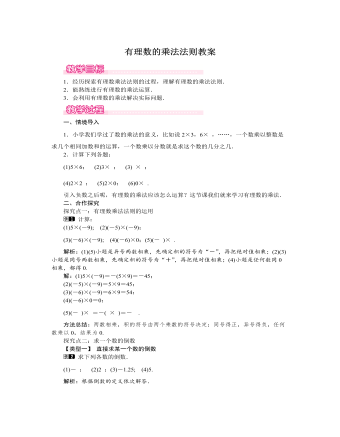
北师大初中七年级数学上册有理数的乘法法则教案1
解:由题意得a+b=0,cd=1,|m|=6,m=±6;∴(1)当m=6时,原式=06-1+6=5;(2)当m=-6时,原式=0-6-1+6=5.故a+bm-cd+|m|的值为5.方法总结:解答此题的关键是先根据题意得出a+b=0,cd=1及m=±6,再代入所求代数式进行计算.探究点三:有理数乘法的应用性问题小红家春天粉刷房间,雇用了5个工人,干了3天完成;用了某种涂料150升,费用为4800元,粉刷的面积是150m2.最后结算工钱时,有以下几种方案:方案一:按工算,每个工100元;(1个工人干1天是一个工);方案二:按涂料费用算,涂料费用的30%作为工钱;方案三:按粉刷面积算,每平方米付工钱12元.请你帮小红家出主意,选择哪种方案付钱最合算(最省)?解析:根据有理数的乘法的意义列式计算.解:第一种方案的工钱为100×3×5=1500(元);第二种方案的工钱为4800×30%=1440(元);第三种方案的工钱为150×12=1800(元).答:选择方案二付钱最合算(最省).方法总结:解此题的关键是根据题意列出算式,计算出结果,比较得出最省的付钱方案.
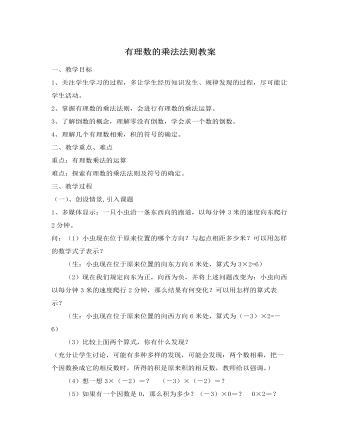
北师大初中七年级数学上册有理数的乘法法则教案2
讨论归纳,总结出多个有理数相乘的规律:几个不等于0的因数相乘,积的符号由负因数的个数决定。当负因数有奇数个时,积的符号为负;当负因数有偶数个时,积的符号为正。只要有一个因数为0,积就为0。(2)几个不等于0的因数相乘时,积的绝对值是多少?(生:积的绝对值是这几个因数的绝对值的乘积.)例2、计算:(1) ;(2) 分析:(1)有多个不为零的有理数相乘时,可以先确定积的符号,再把绝对值相乘;(2)若其中有一个因数为0,则积为0。解:(1) = (2) =0练习(1) ,(2) ,(3) 6、探索活动:把-6表示成两个整数的积,有多少种可能性?把它们全部写出来。(三)课堂小结通过本节课的学习,大家学会了什么?(1)有理数的乘法法则。(2)多个不等于0的有理数相乘,积的符号由负因数的个数决定。(3)几个数相乘时,如果有一个因数是0,则积就为0。(4)乘积是1的两个有理数互为倒数。(四)作业:课本作业题

